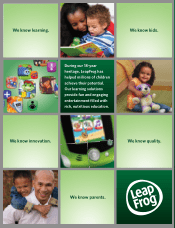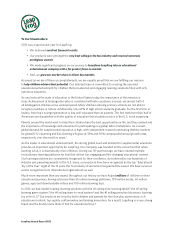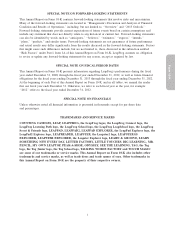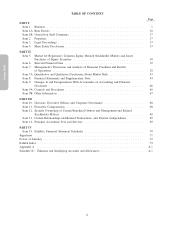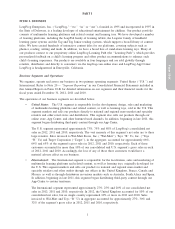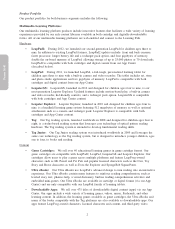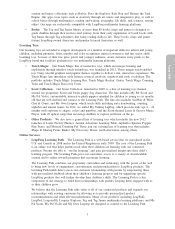LeapFrog 2012 Annual Report Download - page 12
Download and view the complete annual report
Please find page 12 of the 2012 LeapFrog annual report below. You can navigate through the pages in the report by either clicking on the pages listed below, or by using the keyword search tool below to find specific information within the annual report.
•App Center: During 2011, we launched our App Center, through which customers may directly
purchase downloadable digital content with a personal credit card, PayPal or with App Center cards
sold at retailers or our online store. During 2012, we added features including the ability to access
and make purchases via a web browser instead of solely through our proprietary downloadable
software, ratings and reviews, and gifting. Our App Center allows customers to shop for products by
platform, by skill (such as reading and writing or mathematics) or by category (such as games, Ultra
eBooks, music or creativity).
For information on sales of product lines that constituted 10% or more of total net sales by segment, see
Note 20 — ‘‘Segment Reporting’’ in our Consolidated Financial Statements included in this Annual Report on
Form 10-K.
For more information about the risks associated with our new products, see Part I, Item 1A. — Risk
Factors — ‘‘Our business depends on our ability to correctly predict highly changeable consumer preferences
and product trends’’ and ‘‘Our growing strategic focus on online products and services depends on consumer
acceptance of downloadable content and data collection, including our privacy practices’’ in this Annual
Report on Form 10-K.
Competition
Our multimedia platform products compete in the electronic learning-aids category of the toy industry;
however, our product strategy means that we increasingly compete in a broader arena with a variety of
electronic products including tablet computers, eBook readers and mobile devices. Our multimedia platforms,
such as our LeapPad and LeapPad2 learning tablets and LeapsterGS and Leapster Explorer platforms, compete
against handheld gaming platforms from Sony and Nintendo and against mobile devices such as Apple’s
iPhone and iPad and Android-based phones and tablets. Our learning toys compete specifically in the
preschool toy category of the toy industry in the U.S. and selected international markets, in which competition
is significant.
We believe the principal areas of competition in our industry are learning content, performance, features,
quality, brand recognition and price. We believe our learning toys, multimedia learning platforms, and the
related content, online capabilities, and other content compete favorably on these bases. Our products are
sometimes viewed by consumers as premium goods that are more expensive than our competitors’ products.
We believe the LeapFrog brand is recognized for comparably higher quality educational products, enabling us
to compare favorably with many of our current competitors despite premium pricing. In addition, we believe
our learning toy product category is an important competitive differentiator because it introduces parents to the
LeapFrog brand, provides an entry point to the Learning Path and supports our associated strategy to build
direct relationships with customers.
We face the challenge of competitors introducing similar products or functionality soon after we introduce our
new products or product lines, and these competitors may be able to offer their products at lower prices using
cheaper manufacturing processes or materials, more limited functionality, or reduced safety features. In
addition, many of our direct, indirect and potential competitors have significantly longer operating histories,
greater brand recognition and substantially greater financial, technical and marketing resources than we do.
Our principal competitors in the toy industry have included Mattel, Inc., primarily under its Fisher-Price
brand, Hasbro, Inc. and its Playskool division, and VTech Holdings Ltd. For information on how competition
could affect our business, see Part I, Item 1A. — Risk Factors — ‘‘If we are unable to compete effectively with
existing or new competitors, our sales and market share could decline.’’
Our products must also compete for the leisure time of children and the discretionary spending of parents with
other forms of media and entertainment. We design our products to bring fun to learning in order to compete
favorably with these outside competitive influences.
Manufacturing
We are committed to designing and manufacturing products that meet applicable safety and regulatory
requirements. As is the case with most toy manufacturers and many consumer electronics companies, most of
our products are manufactured in China. We actively manage our supplier base, mandating compliance with
U.S. and international safety inspections and enforcing our product standards. Our standards require that we
4


